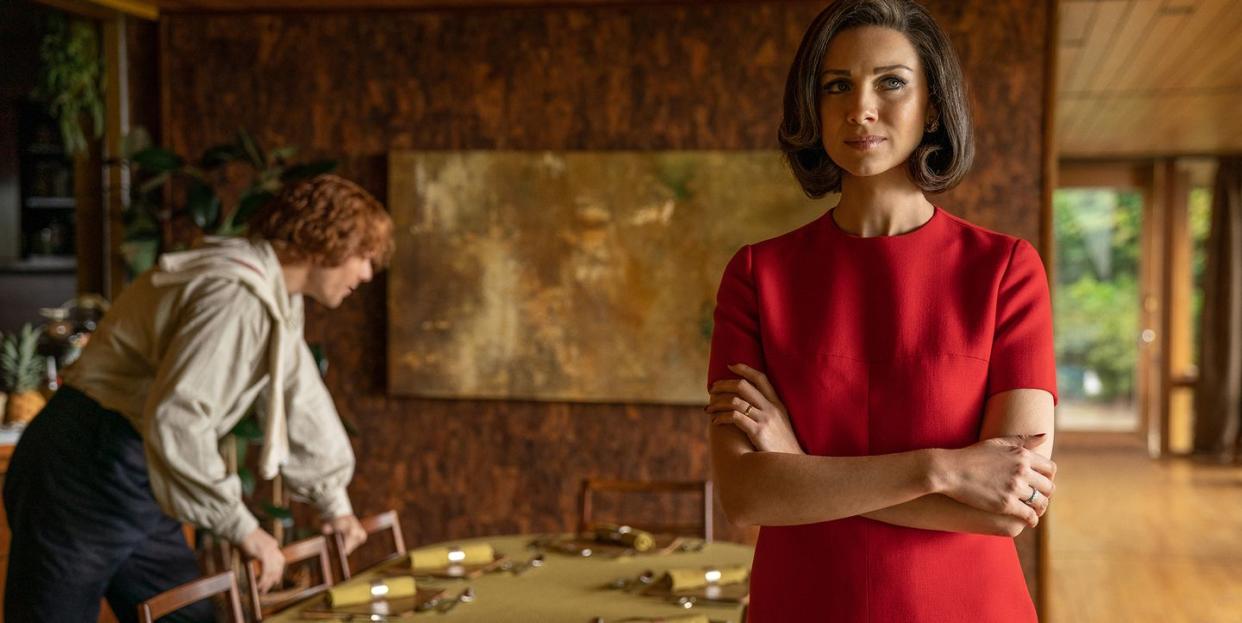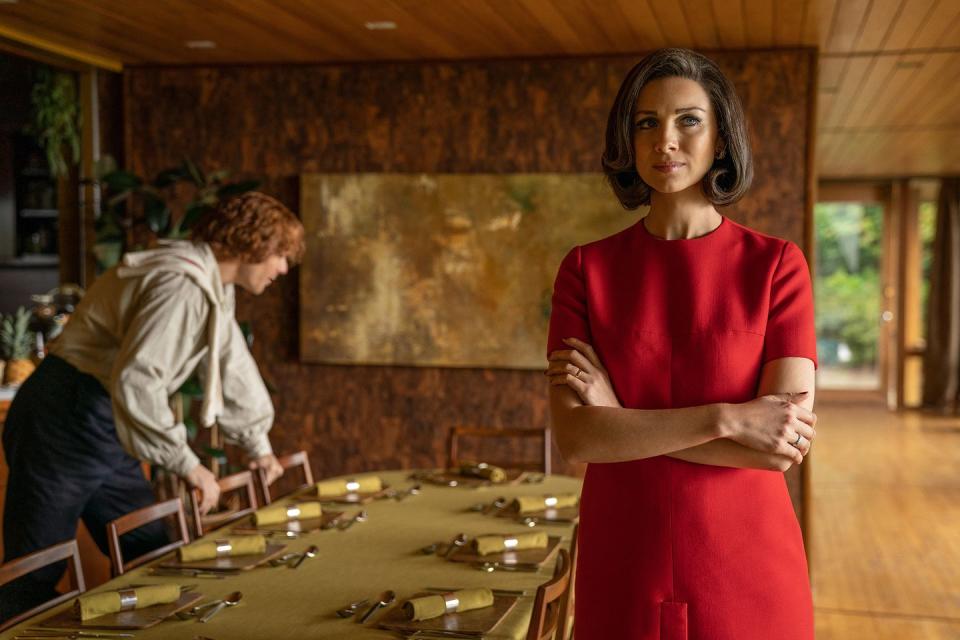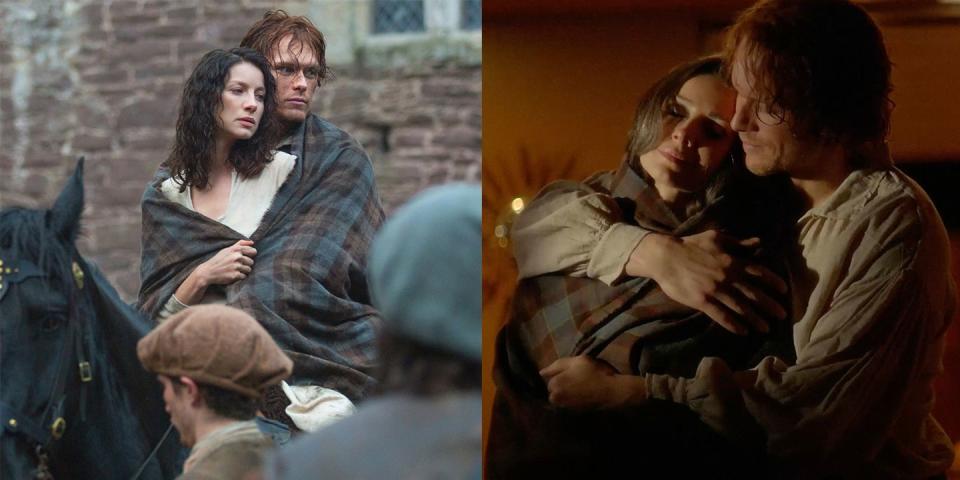Exclusive: The 'Outlander' Producers Break Down Claire's Harrowing Dream Sequence

Warning: This article features an in-depth discussion about sexual abuse. Reader discretion is advised.
Outlander never obscures the realities of 18th-century living, including the prevalence of rape and violence against women during this time. Tonight's season 5 finale tackles one of the book series' darkest and most controversial storylines, following Claire (Caitriona Balfe) as she is kidnapped, beaten, and raped.
But the show diverges slightly from the books, pulling the storyline from the sixth book and giving it a different—and arguably, more legitimate—context. In the book, Claire's kidnapping is presented as a random attack from a group of raiders seeking the family's whiskey cache. But the show depicts it as a personal vendetta against Claire, who spent most of season 5 building a medical practice and encouraging local women to advocate for themselves. Claire's chief attacker, Lionel Brown (Ned Dennehy), resents Claire for encouraging his wife to "avoid [his] bed." As Claire is assaulted, she dissociates, envisioning a world where her family gathers happily at a Thanksgiving dinner table.
In an exclusive video for ELLE.com, the episode's writers, showrunner Matthew B. Roberts and executive producer Toni Graphia; director Jamie Payne; and star and producer Caitriona Balfe spoke about the episode. Read on for a breakdown of the highlights.
The background
Claire is the third member of the immediate Fraser family to be raped on Outlander. Jamie (Sam Heughan) was raped by Black Jack Randall (Tobias Menzies) in the season 1 finale, while the couple's daughter, Brianna (Sophie Skelton) was attacked in the middle of season 4. Several other characters are raped onscreen over the course of five seasons, and the show has received both criticism and praise for its depiction of sexual assault through the years.
“There is quite a lot of rape in this book series, and as a show and as actors, we all feel the responsibility of not taking those storylines lightly and approaching them with sensitivity,” says Balfe. “We worked so hard to make sure that every single beat felt true and honest and respectful.” She adds later in the video, “We can hopefully shed a light on something that people go through in real life and in some way, then, be part of a positive conversation about it.”

The dream sequence
As she experiences the attack, Claire flashes to a dreamlike space in the 1960s—where Brianna and Roger are headed when she last sees them in episode 11—and her family, many of whom can't physically travel to the future, are seen gathered around a Thanksgiving dinner table.
As Graphia explains, Claire “wraps her family around her” to shield her brain from her trauma. “We had done a lot of the research that said women, often during these kinds of attacks, can dissociate, and that’s a safety mechanism that your body and brain does to live through something like this.” she says. This is similar to the preparation Sophie Skelton, who plays Brianna, did for her rape scene in season 4, as she told HarpersBAZAAR.com in 2018:
In my research, I found something out which I didn't really know about: A victim response called tonic immobility, which happens to a lot of women when they get raped. Their bodes go black on them and they go completely numb, so they don't feel anything during the rape. They're not in the room. When Bree's coming to after the rape, she's shaking and her nerves are kicking back in, and she starts to feel the effects of what she's just been through. And apparently, women who have that tonic immobility response then experience worse PTSD later because they go through the trauma afterwards.
These scenes feature several Easter eggs for longtime fans of the series. Graphia points out that Jamie wrapping a (plaid) blanket around Claire is meant to echo a moment from season 1: “That's a symbol of her protection.” There's also an abstract painting of Fraser's Ridge, as Roberts notes.

An orange appears several times throughout the sequence, and Graphia breaks down the season 2 reference to ELLE.com:
[It's] a deliberate echo of the orange that the King of France gives Claire in Season 2, episode 207, “Faith.” After Claire sleeps with the King of France to save Jamie's life, when she leaves Versailles Palace, the last thing she does is pick up the orange and take it with her. It was a small gesture by Claire, a choice that symbolizes that she's leaving with her dignity. Matt and I included it on purpose in Claire's dream-escapes in 612: The orange being visible in the opening shot in her living room, then, when faced with the choice of whether to kill Lionel in revenge, Claire flashes on the orange—and then her walking out with it—a symbol that she takes the high road. She's got a piece of herself that no one can ever take from her. We're hoping the fans who remember the episode in Season 2 will get it!
Depicting violence onscreen
“It was probably the hardest episode that we ever had to film,” Graphia says. Payne adds, “My responsibility as a director is making sure that we’re not shooting anything we don’t need as far as the potential gratuitous nature of that violence.”
Balfe admits it's difficult to film these sequences, but felt worse for the men playing Claire's attackers. “For me, yes, it’s a horrible situation to have to go through these rape enactments, but for the guys I think it was just awful that they had to inhabit these horrible rapists,” she says. “And they were all so respectful. But I think you want it to feel real and visceral.”
If you watched the latest episode and need to talk, @RAINN is here to support you 24/7 on the National Sexual Assault Hotline. Call 800.656.HOPE or visit https://t.co/uyIZ8YuCbu to get help.
— Outlander (@Outlander_STARZ) May 11, 2020
Claire's recovery
Throughout the series, Claire often states her commitment to the Hippocratic Oath: Do no harm. Jamie (Sam Heughan) and the rest of Claire's rescuers captured Lionel after the attack, and once Claire is safe in her home, she has a chance to face Lionel and exact revenge. Instead, she refuses to break her vow, but once she's alone again, she collapses in tears. “She’s strong but she’s not superwoman, so we do have that moment in the hallway where it just hits her, because that’s what happens in real life: You go along and you think you’re gonna be all right, and then she actually faces Lionel Brown,” says Graphia. “So many women do that, like the bravery of the women these days that go to court and face their attacker. That doesn’t mean she’s not damaged and that she won’t feel it for the rest of her life.”
Balfe also discusses her commitment to finding nuance within Claire, even after playing the character for five seasons. “We also tried to shine a light on the fact that even though Claire is this strong character, strength isn’t just bullishness,” she says. “Strength is vulnerability. Strength is also experiencing pain and allowing yourself to be broken, to a certain extent.”
You Might Also Like

